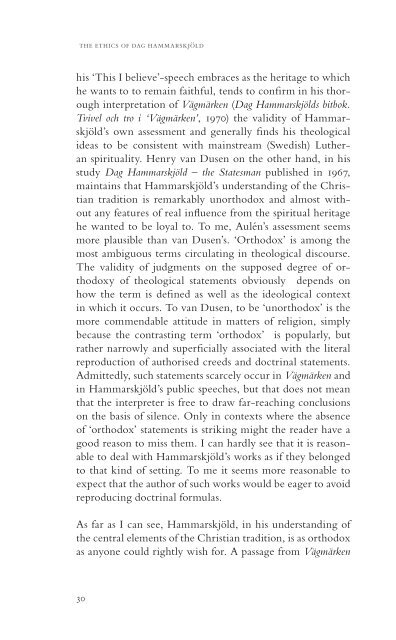Download as pdf - Dag Hammarskjöld Foundation
Download as pdf - Dag Hammarskjöld Foundation
Download as pdf - Dag Hammarskjöld Foundation
Create successful ePaper yourself
Turn your PDF publications into a flip-book with our unique Google optimized e-Paper software.
the ethics of dag hammarskjöld<br />
his ‘This I believe’-speech embraces <strong>as</strong> the heritage to which<br />
he wants to to remain faithful, tends to confirm in his thorough<br />
interpretation of Vägmärken (<strong>Dag</strong> <strong>Hammarskjöld</strong>s bitbok.<br />
Tvivel och tro i ‘Vägmärken’, 1970) the validity of <strong>Hammarskjöld</strong>’s<br />
own <strong>as</strong>sessment and generally finds his theological<br />
ide<strong>as</strong> to be consistent with mainstream (Swedish) Lutheran<br />
spirituality. Henry van Dusen on the other hand, in his<br />
study <strong>Dag</strong> <strong>Hammarskjöld</strong> – the Statesman published in 1967,<br />
maintains that <strong>Hammarskjöld</strong>’s understanding of the Christian<br />
tradition is remarkably unorthodox and almost without<br />
any features of real influence from the spiritual heritage<br />
he wanted to be loyal to. To me, Aulén’s <strong>as</strong>sessment seems<br />
more plausible than van Dusen’s. ‘Orthodox’ is among the<br />
most ambiguous terms circulating in theological discourse.<br />
The validity of judgments on the supposed degree of orthodoxy<br />
of theological statements obviously depends on<br />
how the term is defined <strong>as</strong> well <strong>as</strong> the ideological context<br />
in which it occurs. To van Dusen, to be ‘unorthodox’ is the<br />
more commendable attitude in matters of religion, simply<br />
because the contr<strong>as</strong>ting term ‘orthodox’ is popularly, but<br />
rather narrowly and superficially <strong>as</strong>sociated with the literal<br />
reproduction of authorised creeds and doctrinal statements.<br />
Admittedly, such statements scarcely occur in Vägmärken and<br />
in <strong>Hammarskjöld</strong>’s public speeches, but that does not mean<br />
that the interpreter is free to draw far-reaching conclusions<br />
on the b<strong>as</strong>is of silence. Only in contexts where the absence<br />
of ‘orthodox’ statements is striking might the reader have a<br />
good re<strong>as</strong>on to miss them. I can hardly see that it is re<strong>as</strong>onable<br />
to deal with <strong>Hammarskjöld</strong>’s works <strong>as</strong> if they belonged<br />
to that kind of setting. To me it seems more re<strong>as</strong>onable to<br />
expect that the author of such works would be eager to avoid<br />
reproducing doctrinal formul<strong>as</strong>.<br />
As far <strong>as</strong> I can see, <strong>Hammarskjöld</strong>, in his understanding of<br />
the central elements of the Christian tradition, is <strong>as</strong> orthodox<br />
<strong>as</strong> anyone could rightly wish for. A p<strong>as</strong>sage from Vägmärken<br />
30
















